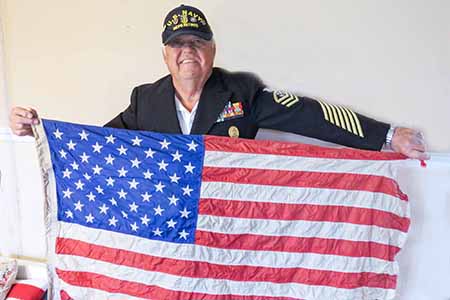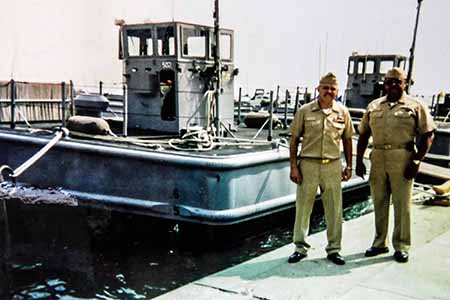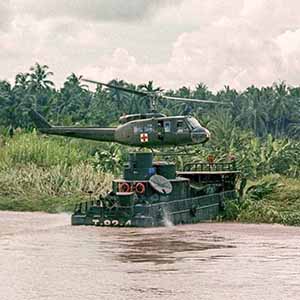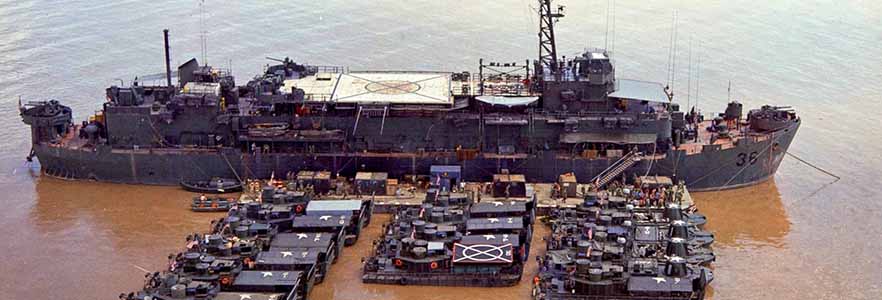Navy Vietnam Downers Grove, IL Flight date: 05/11/22
By Carla Khan, Honor Flight Chicago Veteran Interview Volunteer
“Join the Navy and see the world!” But in Master Chief Boatswain’s Mate Ken Albert’s case, it was not “see the world” but more like “be in the line of fire 24/7 for as long as your Vietnam tour of duty lasts.”
Ken grew up on Chicago’s South Side as the youngest of 5 brothers, 2 of whom had enlisted in the Army and the other 2 in the Navy. Ken opted for the Navy, expecting to get the proverbial hot meal and warm bed. Things turned out differently though but that was not until later. Initially, his draft was deferred because his job as a machine operator had essential wartime skills. However, Ken was tired of answering questions about why he hadn’t been drafted yet so he enlisted in the Navy.
Boot Camp was at Great Lakes during the winter of 1967. Instead of marching, the new recruits spent much of their time cleaning snow after the big blizzard. Between completing Boot Camp and deployment, Ken married Sally, the love of his life. Then he set out for San Diego to the USS Horne for more military training. As an experienced scuba diver, Ken volunteered to become one of the ship’s so-called “swimmers” who rescued downed fliers. Although he qualified, a Naval change of plans sent Ken on his way to Vietnam by way of the Philippines and Hawaii. It was the first ocean trip for this inexperienced sailor from the Midwest who found himself violently seasick the entire way until he, in his words, “found his sea legs” during a fierce hurricane in the Pacific and was never bothered by seasickness again. While on board the USS Horne for a year and a half, he became Commodore C.W. Cummings’ personal driver for his boat as well as his car whenever they pulled into port.
Deployment in Vietnam was going to be for a period of about 12 months. With Ken being promoted to 3rd Class Bosun’s Mate, there now were 5 sailors with this rank making his ship was overstaffed. Ken was to be sent back to San Diego for riverboat training, however he was offered a permanent position by Commodore Cummings. Ken politely declined citing future plans. Instead, he went to the Vallejo Navy Base where he was given a boat along with 60 days of training in how to drive it.
When his riverboat training was completed, Ken next flew to Saigon Air Force Base where he was dispatched to the USS Benewah, an APB-35, a self-propelled barracks ship. Because it had 30 small boats “attached” that would go out onto the Mekong River and come back to their home base, the sailors referred to it as “Mothership.” For now, he had his wish of a bunk, a locker, and a meal but it was far from what he had anticipated so many months ago. However, as Ken repeatedly said, “You do as you are told to do” and pretty soon, he got to drive a boat, RIVRON-15.
The purpose of the RivRon trips was to move troops up and down the river for their multiple missions. These boats had flat bottoms and were powered by 4 engines which made them suitable for operating in very shallow water. However, since they were almost constantly in danger of enemy fire from anywhere on the shore, they stayed in the middle of the river as much as possible. Although in the Navy, the crew wore green uniforms for camouflage purposes and flak vests were mandatory at any time. Death was all around. Just 30 days into Ken’s tour, the enemy, “Charlie” used an unexploded 500-lb bomb with a tripwire which killed several sailors. Among them was a young man, Jimmy, whose body Ken later had to identify. Such were very traumatic experiences for a 21-year-old and they have stayed with him for the rest of his life.





Changes of duty always came quickly. During his next trip back to the Mothership, Ken now got his own boat, a Zippo Boat. This one threw out 2 streams of pressurized napalm at the time to be used for defoliation of the coast of the Mekong Delta so the enemy couldn’t hide. It was an experimental ship and the enemy hated it with the result that Ken and his crew were under more fire than ever before. Their only defenses were a 50-caliber machine gun, a 30-caliber machine gun, as well as grenade launchers. But again, as Ken said, “You go where you are told to go” and so they did for two months with only occasional stops at the Mothership for food.
His next boat was called a Tango Boat, which was a small, flat bottom armored troop carrier with a helicopter deck. The Tango was meant as a small troop carrier which is why a helicopter could land to evacuate wounded soldiers to the hospital located on the Mothership as quickly as possible. During a particularly dangerous mission they were down river in supposedly “friendly” territory to pick up two wounded soldiers when they came under fire. They took care of their wounded men first, which meant that they all were shot at from close range. In Ken’s words, “I threw the patient on the heli but there was a lot of blood.” Only later, he noticed that he himself had been wounded too. A quick bandage was applied till they got to the Mothership where Ken was treated and sent back to do the job he’d signed on for. Sadly enough, the soldier they had rescued did not survive. Ken received a Purple Heart medal, but looking at it reminds him of those critical moments.
Most of the time, the Tango ran missions up and down the river and consequently was also very often under fire and got hit more than once. Sometimes if they happened to pull in after an operation during cocktail hour, free beer was handed out, 2 cans per man. It was referred to as “PBR” which stood for Pabst Blue Ribbon, not the most popular type of beer. Rumor had it that the beer had formaldehyde in it for preservation and whatever it was, the men developed a very high tolerance for alcohol.
In the back of their own boat, they had a cooler which they filled up whenever they pulled up at an Army base. Although one time when they pulled into Dong Tam Harbor with a refueler, they came under fire along with 30 soldiers who were sitting on the dock with their bags, mustering out and waiting to go home. The enemy knew they were unarmed and fired on them. Initially, Ken ran back onto the boat for safety till he remembered that they were carrying 1,200 gallons of fuel to be turned into napalm. He said he left the boat in a hurry!
Soon, Ken was promoted to Boat Captain and during Operation Nighttime, they were ordered to go to a friendly village. Suddenly, he heard the sound of an AK-47 being fired from somewhere out of the dark. Ken stepped aside but his friend, Bill, who had stepped into Ken’s supposedly safe spot, was killed immediately. There was no way out to safety on their own so they called in the protection of “Puff the Magic Dragon”, a DC-7 turned into a special warplane that circled around till Ken’s boat was safe.
He only had one R&R that he had planned to spend with Sally in Hawaii; but because of schedule changes, they only had 3 days instead of a week.
As the boat captain of ASPB (Assault Surface Patrol Boat) A-921, Ken named his boat “Blood, Sweat, and Tears.” Its job usually was defoliation of the river bank which also put them into great danger. Ken estimates that 90% of the time when they were out on the water, they were under some sort of enemy fire and after every incident, he was thankful that he survived. Ken chose to be the forward gunman and still owns the tattered flag they proudly flew. One of their guns, a 20mm gun with 750 rounds to the belt, was manned by Ken on the very front of the boat and he didn’t hesitate using all of the rounds. It certainly was effective, but unfortunately the loud noise also caused Ken permanent hearing loss.
In November, 1969, Ken received his “marching orders” and was to wait on the Mothership for further instructions. Not one to sit still, he volunteered to go with helicopters to pick up the wounded. On the way over, the heli pilot’s idea of fun was to scare his passengers. Ken said the pilot asked him if they could “pick up some rice for dinner” and after the passenger’s affirmative answer, the aircraft dropped to almost ground level over a rice paddy, turned sideways so that rice was cut off and flew into the cabin.
Finally, at the end of November, Ken returned to the USA and flew into O’Hare where Sally, who had been living in Chicago, waited for him at the gate along with her 2 little cousins who were waving small American flags. Ken remembered that in those days, one did not speak of service in Vietnam but repeated, “We had a job to do and we made the best of it.” And he certainly did! After his return, he joined the Navy Reserve for another 26 years and retired with the rank of Command Master Chief, not only the highest non-commissioned rank, but it also is represented in the gold stripes on his uniform, signifying that Ken never was reprimanded during all those years!
In the civilian part of his life, Ken was self-employed. Sally had a successful career in the banking industry, and later operated a daycare center out of the house for 28 years. They have three children and enjoy their nine grandchildren.
Ken would not want to return to Vietnam as a tourist but might consider going back to help search for MIA’s. During the many years he dedicated to his country, Ken did what he was ordered to do and always did the best he could.
Ken, thank you for your heroic service to our country. Enjoy your well-deserved day of honor on this 101st flight of Honor Flight Chicago. And this time around, enjoy a grateful “Welcome Home!”


